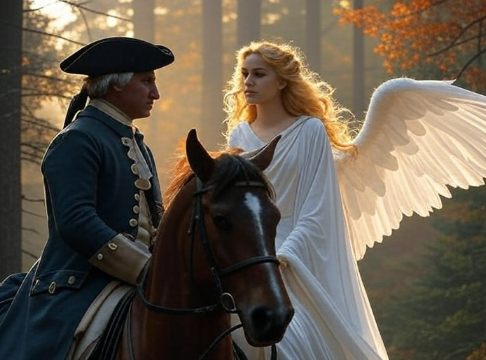The legendary account of George Washington’s vision of a divine light in the woods is said to have occurred during the brutal winter encampment at Valley Forge, Pennsylvania, in late December 1777.
Amid the Continental Army’s dire circumstances—marked by freezing temperatures, rampant disease, and dwindling supplies—Washington, overwhelmed by the suffering of his troops, retreated into a secluded wooded area near his headquarters to pray fervently for guidance and divine intervention. This moment of solitude in the snow-covered forest, away from the camp’s hardships, set the stage for the apparition, as recounted in a narrative attributed to a fictional eyewitness, Anthony Sherman, in an 1880 publication by Wesley Bradshaw in the National Tribune. The exact date remains unverified, but it is traditionally placed shortly after Christmas 1777, during the encampment’s darkest days from December 1777 to March 1778.
In the vision, a brilliant light suddenly illuminated the woods, mesmerizing Washington and immobilizing him as a “beautifully dressed lady” or angelic female figure—often interpreted as the Goddess of Liberty—appeared, accompanied by a radiant angel. She beckoned him to follow her into the heavens, where he witnessed prophetic scenes of America’s future perils.

A shadowy angelic being sprinkled ocean water over Europe and America, unleashing dark clouds of war: the first representing the Revolutionary War itself, with British forces ravaging the land until divine aid turned the tide; the second depicting a fierce internal civil war (foreshadowing the American Civil War), where brother fought brother until a bright angel inscribed with “Union” intervened, restoring harmony; and the third, the most terrifying, portraying a global invasion by armies from Europe, Asia, and Africa overwhelming a divided America, only to be repelled by heavenly legions joining American forces for ultimate victory. The experience unfolded as a vivid, trance-like revelation, with a mysterious voice repeatedly urging Washington to “look and learn,” blending ethereal visuals of billowing storms, clashing battles, and triumphant banners.
The vision’s meaning, as conveyed to Washington, was a profound assurance of America’s divine destiny despite impending trials, emphasizing themes of perseverance, unity, and heavenly protection to inspire his leadership through the Revolution and beyond. It warned of three great crises testing the republic’s resolve—the ongoing war, a future fraternal conflict, and a cataclysmic world war—but promised that fidelity to principles of union and faith would summon angelic intervention for triumph, symbolized by the enduring American flag and the azure standard planted amid the nation’s heartland. Though apocryphal and not corroborated by Washington’s own writings, the tale, popularized in 19th-century patriotic literature, served to portray him as a divinely guided founder, reinforcing national morale and the notion of America as a providential “city upon a hill” ordained for greatness.
Discover more from CYKOSIS™
Subscribe to get the latest posts sent to your email.
